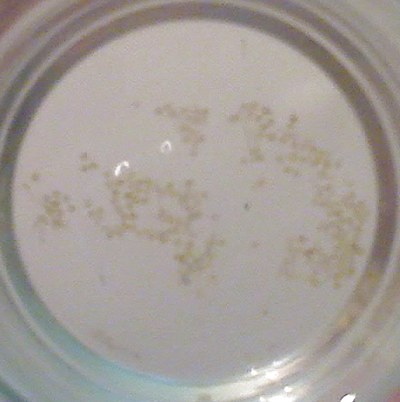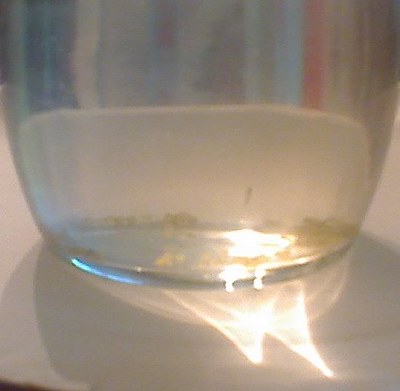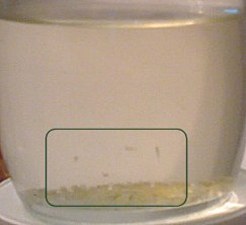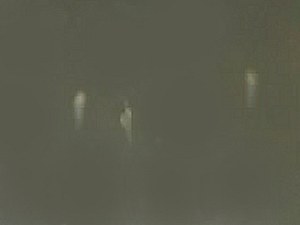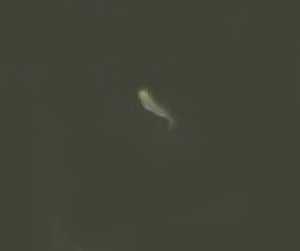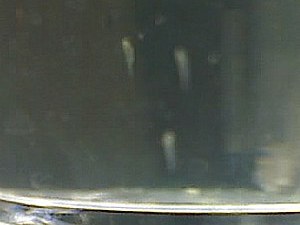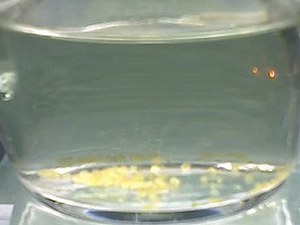Wow. Alexei is a beautiful specimen! :clap:
Alexei is truly amazing. She's a very long, sleek, elegant lady comet. Sprocket's father is Napoleon (still with Flaringshutter) and he is also a spectacular fish. We can see how well Sprocket inherited his fine appearance from both his parents. Not bad for him being a cross between a common feeder fish and a fair-ground prize fish. Who needs a pedigree, anyway?
On the other side of this genetic jumble, we have Cassandra. She was a freebie I got with two other fish in a pathetically small 10-gallon tank I bought second-hand. I wasn't after the fish then, just needed a spare quarantine tank at a cheap price. The other calico fantail you see in the photos (still yet unnamed, sorry) was one of those, plus a small shubunkin who was already sick/malnourished and who didn't survive more than a few days. Judging from the brand names of the supplies I got with this tank, I imagine Cassandra came from our local Petsmart. In the time I've had her (about 8 months), Cassandra's fins have grown way beyond what I would have thought they might.
If I can keep the fry alive and healthy now, it should be interesting to see what kind of fish this comet (Sprocket) and a calico fantail (Cassandra) will produce. Whatever they turn out to be, the finnage should be really nice. And given Cassandra's bright splotchy coloring, some of the color patterns and variety should also be very striking.
oh my gosh!!! your goldfish are all stunningly beautiful and so is your tank!!!!
Thanks, crimsonmoon. The tank is really a mess though. I didn't see any point actually aquascaping in there with two monster-sized comets due to arrive soon. I wasn't sure yet how well they would like such a clutter of plants in the tank. So, I intended to give them 2 weeks or so to settle in first before doing anything more with plants. (Of course, that was the plan before Cassandra spawned.) I ran out of money before getting the eco-complete I wanted, so I opted for 16 grit silica sand as the substrate ($6 for 100 lbs. at Lowe's). Only half of the sand has been added so far.. I wanted to get some MTS going in there before building the depth up any higher (to avoid anaerobic spots). So, most of the plant roots are still exposed and they get uprooted a lot. I just stick them back down there for now.
The silica sand is working even better than I expected. It looks like sand, but the grains are heavy enough that it still vacuums like gravel. It wasn't dusty at all and has a natural look. This picture I took of a moss ball shows what the substrate looks like a little better.
So that's the substrate, the volume is 110 gallons and it gets 322 watts of light, both 6700K and 10,000K dual compact fluorescent bulbs. There are many snails (at least 3 kinds who're known for eating plants, btw)... marisas, spixis, a single cana, diffusas/briggs, trumpet snails (2 kinds), olive nerites, and one viv that I haven't seen since it arrived. I find an occasional common ramshorn or pond snail thanks to all these plants... but not very many. (I also put those back in.. don't have the heart to kill pond snails and no one to feed them to. The goldies might eat some of them, not sure.) I don't always burn both bulbs at the same time, so between that and all these snails, there's not a speck of algae anywhere. I'm keeping the water level low now because my air pump went out a few days before Alexi and Sprocket got here. No more bubble wand for until I buy another pump. So I'm using the spray bar to agitate the water surface and push air down into the water column. That's also quite handy for rinsing duckweed off my arm when I've been doing something in there.
Still Day 4 for the eggs. I lose count of the fry at around 20 because these little buggers dart around too much. I keep removing empty egg shells as I find them.. and trying to keep the water fresh. None of the remaining eggs have turned white and more keep hatching. I've tried different things to get better pictures of the fry and the eggs, but nothing has improved that way.
Have two more photos to show you, one to see how many eggs are left to hatch and another to show a newly hatched fry on the side of glass. Same kind of thing as you've already seen, I'm afraid. Tomorrow morning, I'll start separating the fry from the eggs, so those won't stay together in one container.
